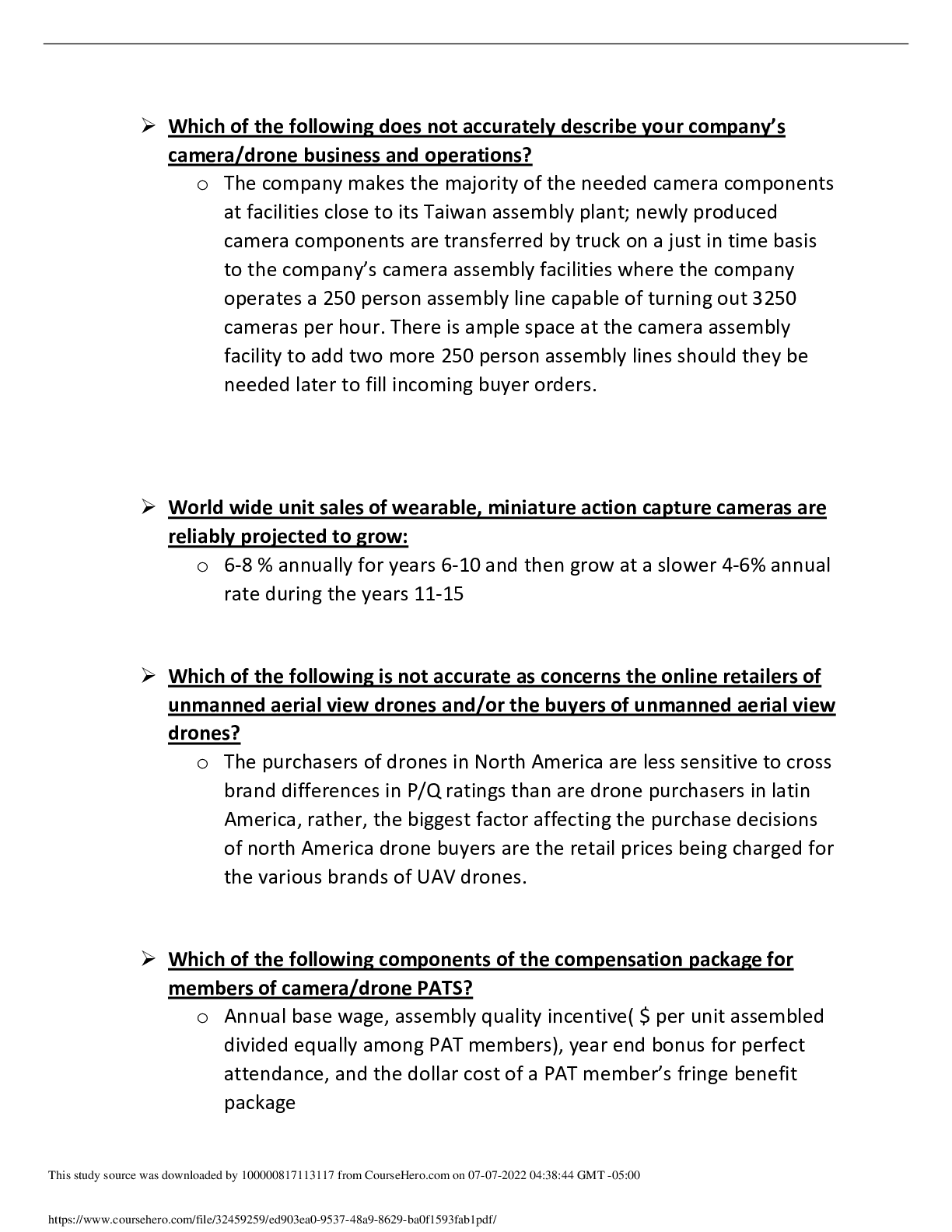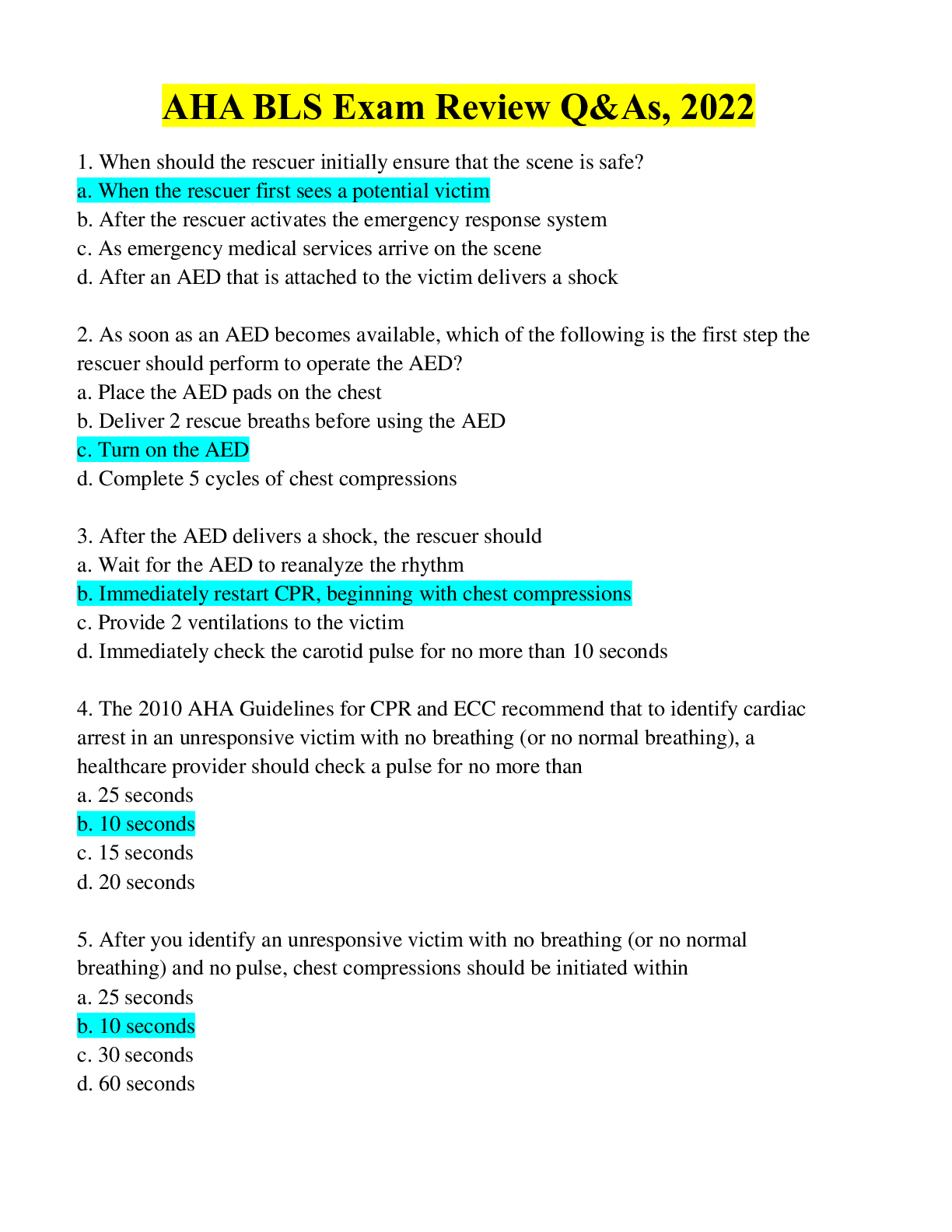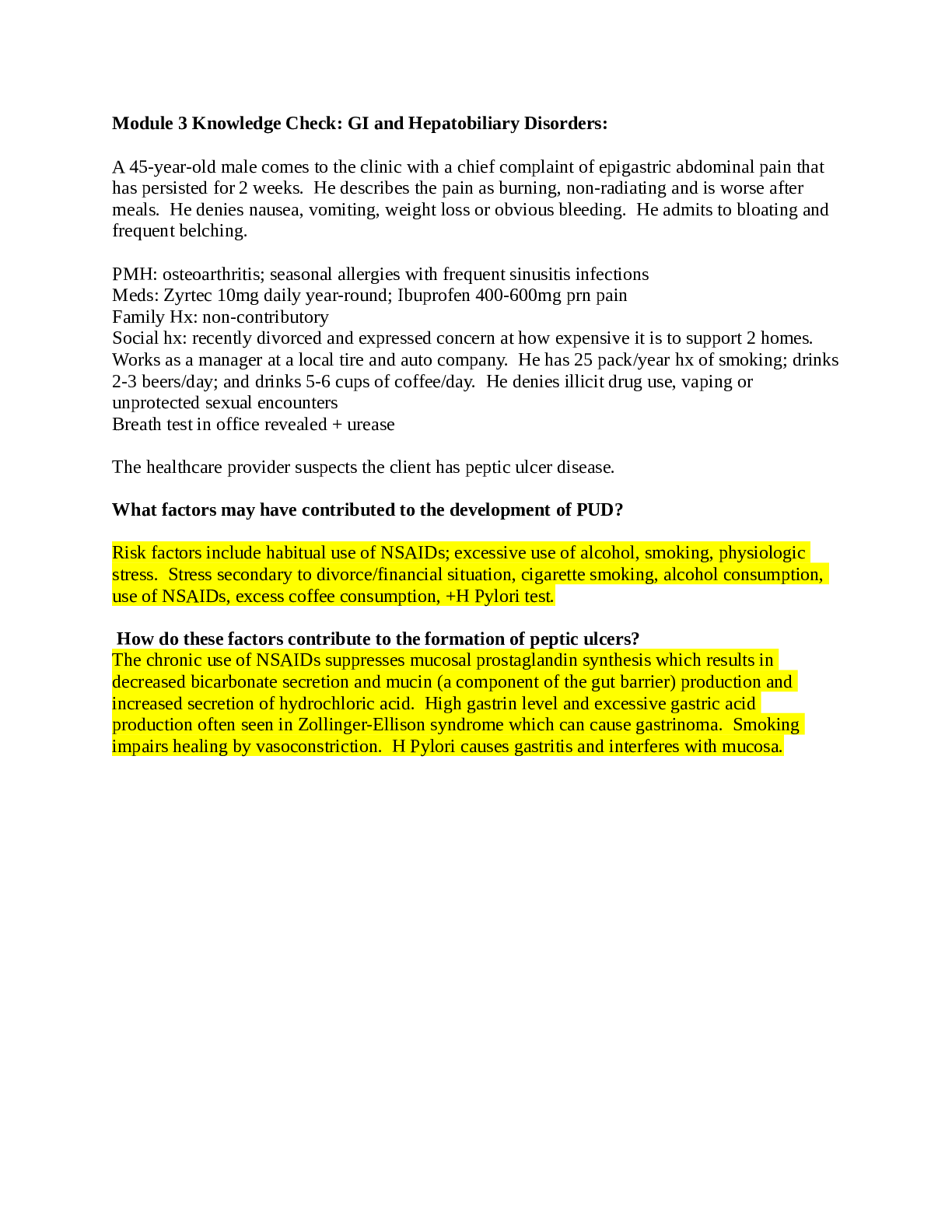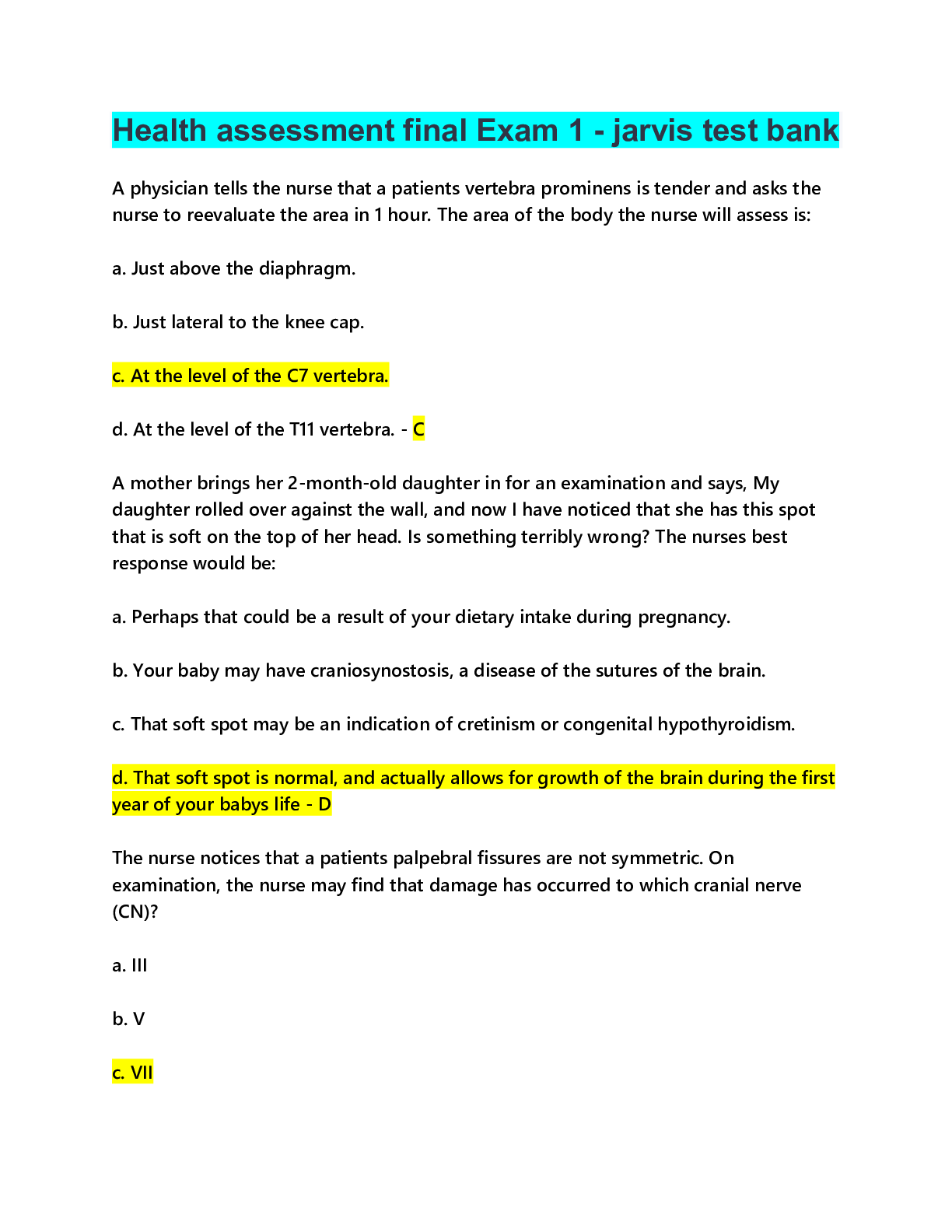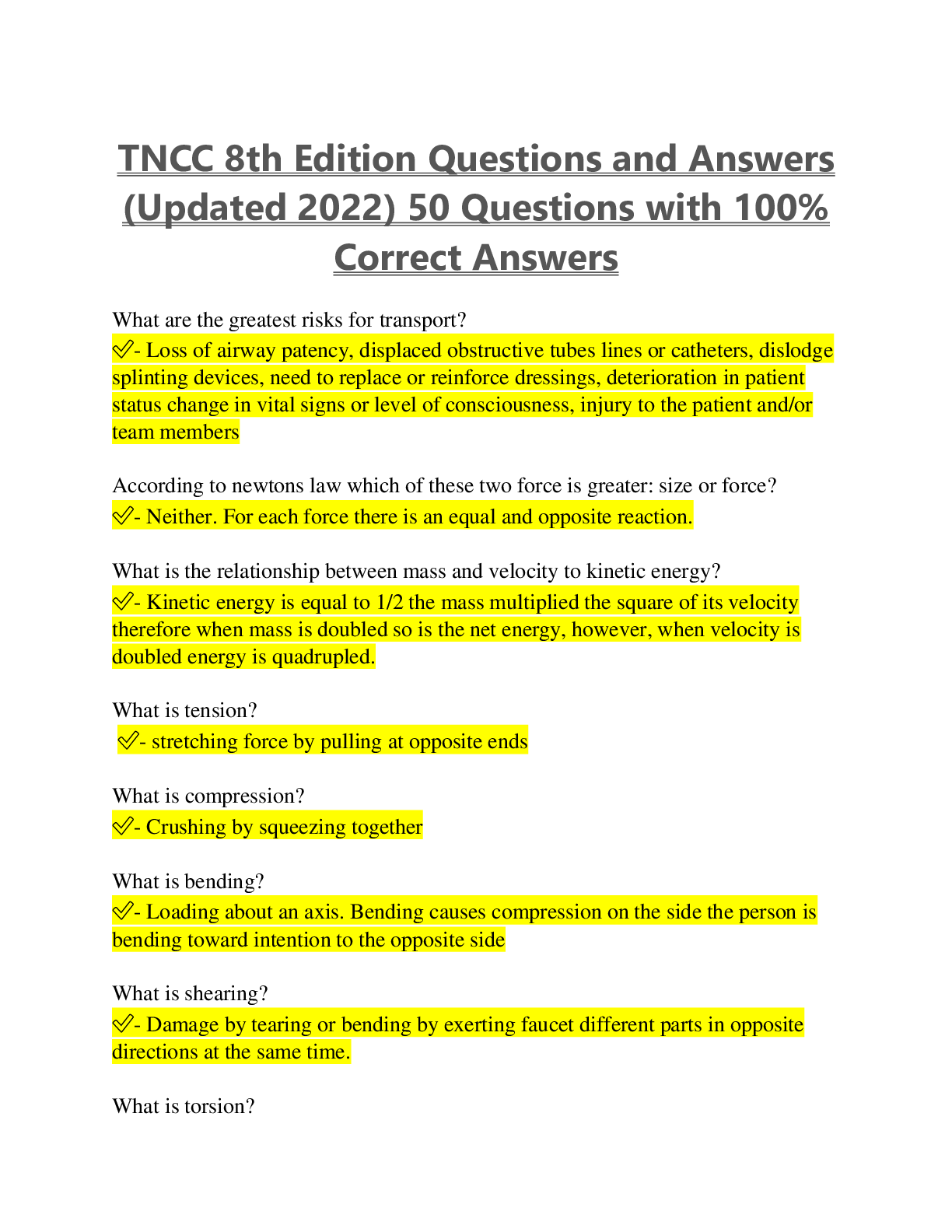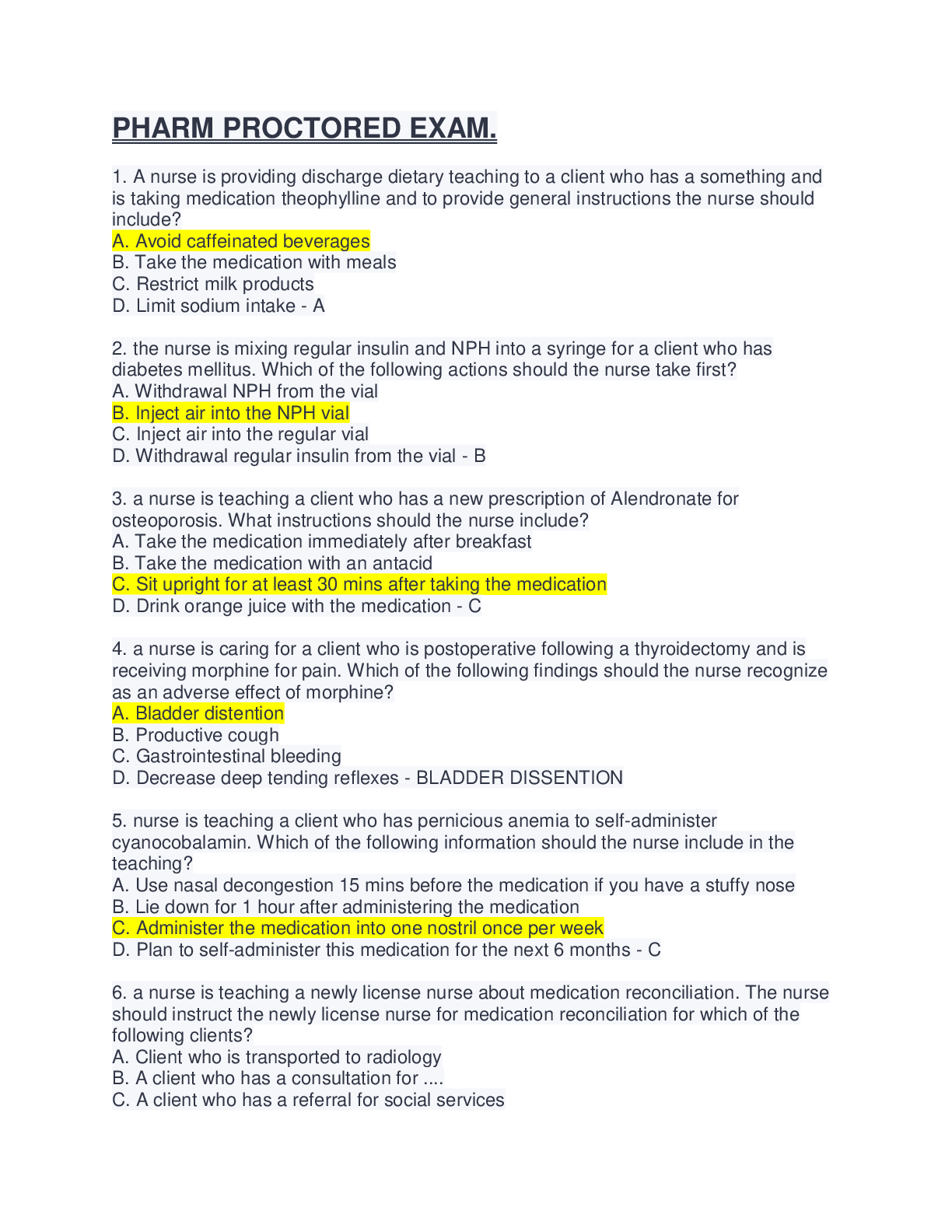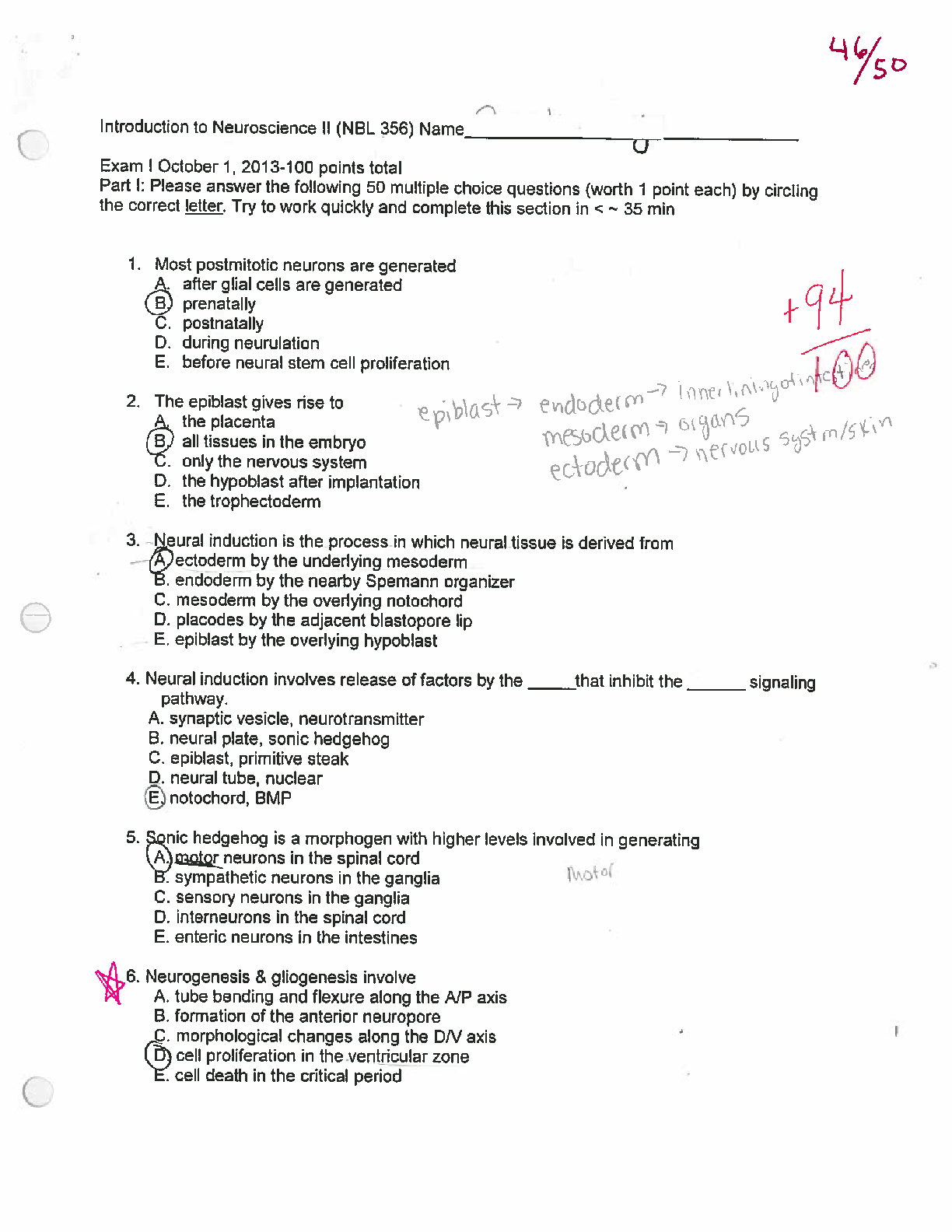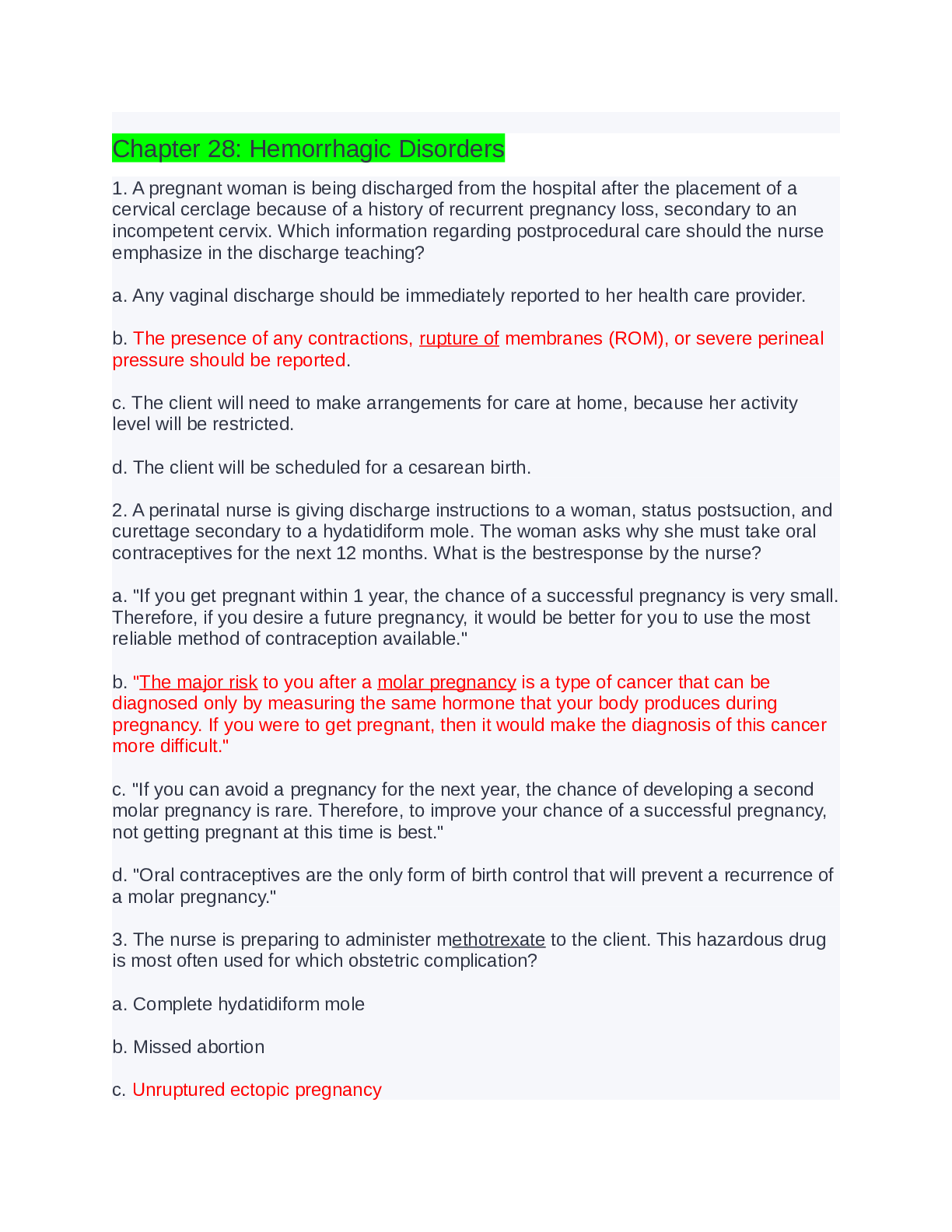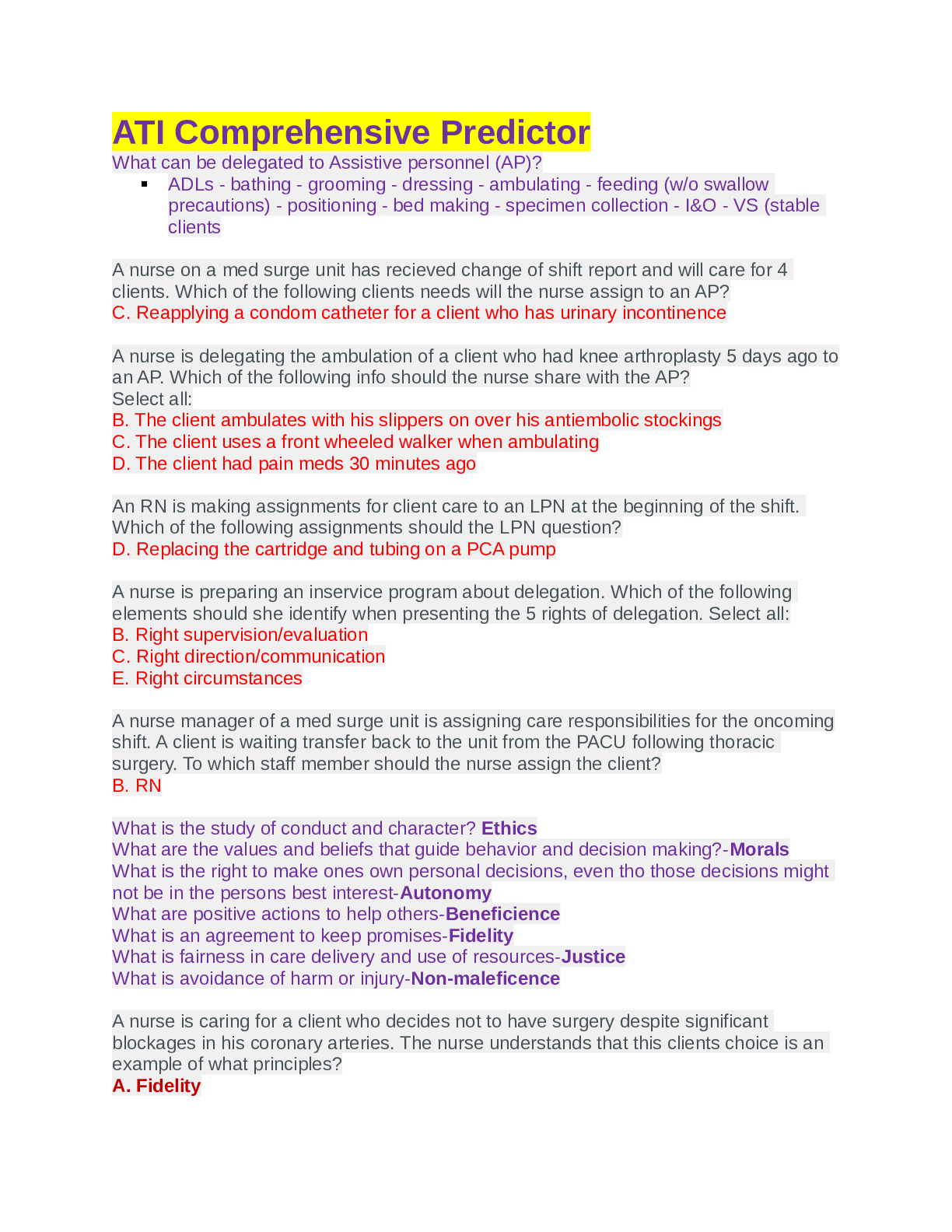Biology > QUESTIONS & ANSWERS > University of Alabama, Birmingham - BIO 101 Exams Test bank / BIO 101 multiple exams tests, latest 2 (All)
University of Alabama, Birmingham - BIO 101 Exams Test bank / BIO 101 multiple exams tests, latest 2021.
Document Content and Description Below
Bio Exam One 1. The presence of a cell wall and cell membrane, but the absence of cellular organelles would be a description of which of the following classes of cells? a. prokaryotic cells b. ... eukaryotic cells 2. Which one of the following is a function of a protein? a. serves as an enzyme and speeds up a chemical reaction b. stores genetic material and enables its transmission to the next generation c. provides energy for a muscle contraction d. is a primary structural component of DNA 3. Which of the following molecules is broken down as a result of the metabolic process known as glycolysis? a. pyruvate b. carbon dioxide c. glucose d. ATP 4. The purpose of the Krebs cycle is to produce high energy carrier molecules like NADH and FADH2 that then feed into the electron transport chain. During this process, another by-product molecule is produced. Which molecule is produced during the Krebs cycle? Hint: the Krebs cycle is part of aerobic respiration. a. water b. carbon dioxide c. lipids d. glucose Question 5 2 / 2 pts One of the end products of glycolysis is: fructose glucose carbon dioxide pyruvate Question 7 0 / 2 pts The purpose of glycolysis and the Krebs cycle is to use split glucose to harness the energy in the bonds thereby generating high energy molecules that feed electrons into the electron transport chain. If an organisms has a defect in an electron chain molecule but can complete glycolysis, would the organism be able to survive? No, the organism would not be able to produce any energy. No, the organism would not be able to control the large amount of energy produced. Yes, although the organism may be limited in size because only a small amount of energy is produced. Yes, although the organism would not have any way of controlling the large amount of energy produced. wrong Question 8 2 / 2 pts Which of the following is an incorrect base pairing for DNA? cytosine - guanine adenine-thymine adenine- urocil thymine - adenine Question 9 2 / 2 pts Fill in the missing term in the following sequence: A gene comprised of DNA is transcribed to make messenger ________ which is then translated to protein. DNA enzyme RNA ATP Question 10 2 / 2 pts The energy molecule produced as a result of cellular respiration is: ATP fat GTP dNTP Question 11 2 / 2 pts The type of bond that holds together two amino acids in a protein (polypeptide chain) is called: lipidosidic peptide rolltide aminocidic Question 12 2 / 2 pts When two macromolecules are joined by a covalent bond during a biochemical reaction, a(n) ______________ molecule is given off by a process called condensation or dehydration synthesis. ATP water ADP coenzyme Question 13 2 / 2 pts In which of the following would you find lipids? applesauce butter water diet soft drinks Question 14 2 / 2 pts In cellular respiration, most of the ATP's are produced during which process? electron transport reaction photosynthesis Krebs cycle fermentation glycolysis Question 15 0 / 2 pts Which of the following molecules is used directly within the cell to perform functions that require energy: Protein wrong fats ATP carbohydrates Question 16 2 / 2 pts Nucleic acids are found within the cell: free-floating in the cytoplasm in the nucleus in the lysozyme in the cell membrane Question 17 2 / 2 pts Which one of the following forms a bilayer structure that is found in cell membranes? phospholipids nucleic acids proteins amino acids Question 18 2 / 2 pts Which of the following macromolecules could be described as an unsaturated fatty acid? (Think: what is the difference between saturated and unsaturated fatty acids?) HOOC-CH2-CH2-CH2-CH2-CH=CH-CH2-CH2-CH3 HOOC-CH2-CH2-CH2-CH2-CH2-CH2-CH3 HOOC-CH2-CH2-CH2-CH2-CH2-CH2-CH2-CH2-CH2-CH2-CH3 Question 19 2 / 2 pts The most important physical characteristic of lipids with regard to living organisms is that they are typically a form of waste product that is difficult to eliminate are very large and therefore difficult to store dissolve easily in water are denser than water are hydrophobic Question 20 2 / 2 pts Which of the following represents the correct order of the phases of the cell cycle? G1 and G2 are 'rest' periods S is the 'Synthesis' period M stands for mitosis G1 -> M -> G2 -> S G1 -> S -> G2 -> M G1 -> G2 -> S -> M G1 -> S -> M -> G2 G1 -> G2 -> M -> S Question 21 2 / 2 pts The division of the cytoplasm in the final stage of mitosis is called _____________. mitosis. cytokinesis. cytogenetics. synapsis. meiosis. Question 22 2 / 2 pts Examine the following image of a virus. Which microscope was used to obtain this image? Electron microscope Scanning light microscope Light microscope Question 23 0 / 2 pts There are different types of microscopes that can be used to provide information about cells. Which type of microscope is used for the observation of living cells? scanning electron microscope wrong transmission electron microscope light microscope Question 24 2 / 2 pts Which type of microscope is pictured below? light microscope transmission electron microscope scanning electron microscope Question 25 2 / 2 pts Two functions of adult stem cells include homeostasis (natural turnover/ wear and tear) and wound repair. True False Question 26 0 / 2 pts Epidermal stem cells and liver stem cells are both good examples of ________________. unipotent stem cells fetal stem cells embryonic stem cells multipotent stem cells wrong Question 27 2 / 2 pts Which of the following IS NOT a characteristic of both embryonic and adult stem cells? They can self-renew They all have the potential to develop into any type of body tissue. They may one day be used to generate cells and tissues to treat diseases such as heart disease and diabetes. They can divide endlessly. Question 28 2 / 2 pts Somatic cells are best defined as: the gametic cells (egg or sperm) that give rise to a fully functional individual cells that result after somatic cell nuclear transfer (SCNT) is performed any body cell other than the gametes (egg or sperm); sometimes referred to as "adult" cells. relatively rare undifferentiated cells found in many organs and differentiated tissues with a limited capacity for self renewal and differentiation. Question 29 2 / 2 pts Therapeutic cloning (or somatic cell nuclear transfer) is a possible laboratory tool for creating stem cells specific to a particular individual. True False Question 30 2 / 2 pts Primitive (undifferentiated) cells that are capable of dividing without differentiating for a prolonged period in culture and are known to develop into cells and tissues of the three primary germ layers are known as: embryonic stem cells degenerative stem cells nuclear stem cells adult stem cells IQuestion 31 0 / 2 pts Which of the following statements DOES NOT accurately define cellular differentiation? Cellular differentiation is controlled by the interaction of a cell's genes with the physical and chemical conditions outside the cell, usually through signaling pathways involving proteins embedded in the cell surface. Cellular differentiation is the process whereby an unspecialized embryonic cell acquires the features of a specialized cell such as a heart, liver, or muscle cell. wrong Cellular differentiation involves a complex series of chemical and biological pathways. Cellular differentiation occurs only very early in life. Question 32 6 / 6 pts Match the following terms with the correct definition. Ribosome – Organelle for Synthezing Proteins Lysosome – Functions in digestion and self-destruction Mitochondria – Synthesizes most of a cell’s ATP Golgi Apparatus – Modifies, packages and sorts for secretion or use within the cell Nucleus – Houses the genomic material of the cell Cell membrane – Creates a selectively permeable barrier around the cell. Question 34 2 / 2 pts Metabolism is the overall process through which living systems acquire and use free energy to carry out various functions. True False Question 35 0 / 2 pts The synthesis of biomolecules from simpler components is called: metabolism catabolism wrong anabolism enzymatic Question 36 2 / 2 pts Which of the following is not a product of fermentation? lactic acid carbon dioxide oxygen ethanol Question 37 2 / 2 pts The region of an enzyme where the catalytic reaction occurs is known as: substrate site metabolic site product site active site Question 38 2 / 2 pts Newborn screening is best defined as: A state-run program designed to collect metabolic data on young infants A federal-run program to collect data on the prevalence of metabolic and hormonal disorders in newborns A treatment program designed to prevent metabolic disease early in life A prevention program designed to identify several different disorders (metabolic, hormonal) prior to permanent damage. Question 39 2 / 2 pts A(n) _________ occurs when abnormal chemical reactions in your body disrupt the processes your body uses to get or make energy from the food you eat.. When this happens, you might have too much of some substances or too little of other ones that you need to stay healthy. mitotic disorder enzymatic reaction chemical imbalance metabolic disorder Question 40 0 / 2 pts Potential risks of newborn screening include: I. False positive result II. Parental anxiety III. Rare, but present, risk of infection as a result of heel stick IV. Contracting a metabolic disorder as a result of the screening I, II, and IV I, II, III, and IV I, II, and III I and II wrong Question 41 2 / 2 pts The number of conditions screened for under newborn screening programs differs from state to state. True False Question 42 2 / 2 pts Sample collection for newborn screening generally involves: genomic DNA testing blood serum collection IV blood collection heel prick and blood collection Question 43 2 / 2 pts Which of the following is NOT TRUE for the metabolic disorder, PKU? Treatment can be as simple as following a special diet. An afflicted individual cannot properly breakdown the amino acid phenylalanine. All screening tests showing a positive PKU result in first testing cycle will result in a positive follow-up result. If left untreated, the individual risks possible mental retardation. Question 44 2 / 2 pts The actions of an enzyme can be affected by: temperature pH, temperature, and shape of the enzyme pH enzyme shape Question 45 2 / 2 pts The development of the newborn screening program, particularly PKU screening, is largely attributed to: Zaccharias Janssen Robert Guthrie Anton van Leeuwenhoek Louis Pasteur Question 46 0 / 2 pts The result of mitosis is the production of two daughter cells that are genetically identical to each other but not to the parent cell. True False Bio Exam Two Question 1 2 / 2 pts Three letter nucleotide 'codes' that call for a specific amino acid to be placed into the growing protein chain are called _______. proteins mRNA DNA codons Question 2 2 / 2 pts If both alleles of a particular gene are identical, the person is said to be _________ for that particular gene. heterozygous phenotypic genotypic an identical twin homozygous Question 3 2 / 2 pts In protein synthesis, transcription is when message RNA is made using DNA as a template and translation is the process in which protein (polypeptide) is made. True False Question 4 2 / 2 pts Transfer RNA (tRNA) is a molecule responsible for transporting amino acids to ribosomes during protein synthesis. True False Question 5 2 / 2 pts When two rabbits having the genotype Bb mate (Bb x Bb), the ratio of black–furred offspring to white–furred offspring is 1:2:1. “B” allele confers black fur; “b” allele confers white fur. (Work this out to be sure). True False Question 6 0 / 2 pts The template molecule for protein synthesis is called _________. mRNA tRNA ribosome DNA wrong Question 7 2 / 2 pts An individual homozygous recessive for Trait XYZ (genotype = aa, phenotype = green feathers) mates with a homozygous recessive individual for the same trait. The genotype for an offspring of these two individuals is: green feathers. AA. not listed. aa. Question 8 2 / 2 pts Ribosomes are the major protein molecules involved in protein synthesis. True False Question 9 2 / 2 pts An example of a genotype is: homozygous dominant long fingers attached earlobes brown hair color Question 10 2 / 2 pts Protein production occurs when the ribosome reads the codons of the mRNA transcript. How many nucleotides are found in each codon? 1 3 2 4 Question 11 2 / 2 pts In the production of RNA from DNA, specific pieces of the RNA molecule are removed from the original copy that results in the final, mature RNA copy. The pieces that are removed are called: exons splicesomes introns splicetrons Question 12 2 / 2 pts DNA is organized in each cell to allow for tight packing of a large amount of genomic information. The structure of packed DNA is called a(n): chromosome lipid protein RNA molecule enzyme Question 13 2 / 2 pts Which of the following crosses might lead to the production of offspring that would die from a lethal,recessive disease? Aa x AA AA x aa Aa x aa AA x AA Question 14 2 / 2 pts Humans are similar in _______ of their DNA. 99.9% 50% 10% 90% 100% Question 15 2 / 2 pts The Human Genome Project is best described as: an effort to compare the human genome to the great apes and the banana an competitive exercise to determine whether a consortium of government agencies can be as efficient as a private corporation an extensive effort to determine the entire sequence of the 3 billion base pair human genome. an attempt to sequence each human in the United States. Question 16 2 / 2 pts A single base pair mutation in a gene can be sufficient to cause disease. True False Question 17 2 / 2 pts Which of the following statements is most accurate? Genes only encode for proteins that turn into enzymes. Genes encode for DNA that will fold and function regardless of its shape. Genes encode for proteins that must have a particular shape or structure to function properly. Genes only encode for linear enzymes that perform a specific role in the cell. Question 18 2 / 2 pts The ______________ sequence of a protein is a key determinant in how a protein folds. deoxyribose nucleotide amino acid DNA Question 19 2 / 2 pts Proteomics is best defined as: the study of a single gene and the protein that is expressed from this gene. the study of a single molecule – the size, structure, and relationship of this protein to others in the organism. the study of the collection of an organism’s protein molecules, their sizes, structures, and relationships. the study of the collection of genes that generate the proteins that comprise all living organisms. Question 20 0 / 2 pts Humans have approximately 500,000 to 1 million genes – a much larger number of genes than believed to exist prior to the completion of the Human Genome Project. True False Question 21 2 / 2 pts Based on the information below, answer the following question. "In humans, the ability to roll the tongue is a dominant trait; the inability to roll the tongue is a recessive trait." If two individuals heterozygous for this trait have a child, what is the chance that the child will not be able to roll his tongue? 75% 50% 100% 0% 25% Question 22 2 / 2 pts Even simple modifications to proteins (adding sugar molecules, amino acid insertions or deletions) may alter the structure and function of the protein True False Question 23 2 / 2 pts A display of an individual’s chromosome profile is known as a(n)_____ DNA profile karyotype translation event genomic sequence Question 24 2 / 2 pts DNA is organized and arranged in the nucleus into structures known as: chromosomes the nucleolus ribosomes histones mitotic spindles Question 25 2 / 2 pts Jane is examining some data on the computer. She is studying a small section of a human gene. The sequence on the screen represents one strand of DNA and reads 5’ATGGTTCAAACC 3’. She is wondering what the correct sequence of the other strand of DNA would read. Select the correct sequence for the other strand of DNA from the list below. 5’AUGGUUCAAACC 3’ 5’ATGGTTCAAACC 3’ 3’TACCAAGTTTGG 5’ The correct answer is not listed. Question 26 0 / 2 pts Which of the following characteristics is true of DNA? I. It is generally double-stranded in organisms. II. It consists of the nucleotides A, C, T, G III. The sequence of one strand can be used to predict the sequence of the other strand IV. Structure was determined by Watson and Crick I, II, III, and IV I and II I and II and III The correct answer choice is not present wrong Question 27 2 / 2 pts The process of making RNA from DNA is known as: transcription conjugation dehydration synthesis translation Question 28 2 / 2 pts The process of making proteins from RNA is known as: this process cannot happen translation transcription conjugation Question 29 2 / 2 pts Which of the following is NOT one of the bases in a DNA molecule? thymine adenine uracil guanine cytosine Question 30 2 / 2 pts Cytosine will form a base pair only with: guanine adenine thymine uracil cytosine Question 31 2 / 2 pts DNA assumes a form known as a? double helix step ladder six sided figure triple-linked chain Question 32 2 / 2 pts Messenger RNA is synthesized in the cell in the _______. ribosome mitochondria endoplasmic reticulum nucleus Question 33 0 / 2 pts Which of the following correctly describes messenger RNA? I. single stranded II. uracil replaces thymine III. serves as the template for protein production I only I and III only I, II,and III I and II only wrong Question 34 2 / 2 pts Which of the following are actual types of RNA? mRNA and tRNA qRNA mRNA tRNA Question 35 2 / 2 pts A additional nucleotide was accidentally added to the gene sequence when an mRNA transcript was being generated. Which of the following are possible outcomes of this insertion event? I. A stop codon is accidentally created causing a 'short' protein to be made II. The wrong amino acids are added to the protein chain downstream of the insertion event III. The protein gets 1 additional amino acid because a single nucleotide was added to the mRNA strand. I and II only I, II, and III I only II only Question 36 2 / 2 pts In Mendel’s garden peas, the tall allele (D) is dominant over the dwarf allele (d), and the green pod allele (Y) is dominant over the yellow pod allele (y). Using the symbols provided above, what is the genotype of a heterozygous tall, homozygous green pod pea plant? DdYY DdYy DDYY ddYy DDYy Question 37 2 / 2 pts A recessive gene can be expressed if the genotype is: homozygous recessive homozygous dominant heterozygous heterozygous recessive Question 38 2 / 2 pts Phenotype is best defined as: the same for parent and offspring the genetic make-up of an individual the appearance of an individual not observable Question 39 2 / 2 pts In animal X, brown eyes (B) is dominant to blue eyes (b). A brown-eyed animal marries a blue eyed animal. The possible eye colors of their offspring are: brown or blue blue brown green Question 40 2 / 2 pts During a summer job at Virotech, you isolate a previously unknown virus. Analysis of its genome reveals that it is composed of a double stranded DNA molecule containing 14% T (thymine). Based on this information, what would you predict the %C (cytosine) to be? 14% 36% 28% 72% Question 41 2 / 2 pts Down syndrome results from: none of the above the absence of both chromosomes in position 21 the absence of one chromosome in position 21 the presence of an extra chromosome in position 21 Question 42 2 / 2 pts The human genome is comprised of: none of the above one set of 23 chromosomes two sets of 13 chromosomes – 26 chromosomes total two sets of 23 chromosomes – 46 chromosomes total Question 43 2 / 2 pts In order to fit all of the genetic material into the nucleus of the cell, the DNA is packaged tightly and wound around proteins such as histones which ultimately pack into chromosomes. True False Question 44 2 / 2 pts Examine the following Punnett square and correctly identify the genotype of the unidentified parent. ? ? T Tt Tt t tt tt TT Tt tt cannot tell from information provided Question 45 2 / 2 pts A nucleic acid was analyzed and found to contain 32 percent A, 18 percent G, 18 percent C, and 32 percent T. The nucleic acid must be: single-stranded DNA single-stranded RNA double-stranded RNA double-stranded DNA Question 46 2 / 2 pts Humans share a significant portion of their genes with other non-related species True False Question 47 2 / 2 pts Which of the following is true of viral genomes? I. Viral genomes can consist of DNA or RNA II. Viral genomes can be single or double stranded III. Some viruses integrate their genomic material into the genome of their host II only I, II, and III I and II I only Question 48 2 / 2 pts Although a cell contains all of the genes of the human genome, gene expression is regulated throughout the life of the cell allowing for certain genes to be turned on and turned off depending on the condition of the cell. True False Question 49 2 / 2 pts A mutation in the genome of an individual can result in abnormal protein production that leads to disease presentation in a human. True False Question 50 2 / 2 pts The cost of genome sequencing has considerably decreased over the past 10 years leading to a greater number of completed sequences. True False Exam 3 Question 1 2 / 2 pts Oxygen is transported through the lymphatic system in combination with hemoglobin. True ct! False Question 2 2 / 2 pts Which of the following is a major contributor to air pollution? transportation vehicles (diesel trucks, automobiles, etc) small engine machines (lawnmowers, leaf blowers, edgers, etc) smoke (land clearing, woodstoves) All of the answer choices are major contributors of air pollution. Question 3 2 / 2 pts The function of the mucous that is normally secreted in the respiratory system is to assist in cleaning the air before it reaches the alveoli of the lungs. True False Question 4 2 / 2 pts The primary function of the respiratory system is to provide a means of delivering oxygen to and eliminating carbon dioxide from the tissue cells of the body. Correct! True False Question 5 2 / 2 pts Particulates are fine solids that combine with nitrogen dioxide to create the haze we associate with air pollution. Correct! True False Question 6 2 / 2 pts Larger particulate particles (PM2.5) are more dangerous than the smaller particles because they can travel deep into the lungs. True ! False Question 7 2 / 2 pts Particular matter can cause a reaction in the body leading to heart problems as well as lung problems. Correct! True False Question 8 2 / 2 pts The epiglottis is a structural component of the cardiovascular system. True Correct! False Question 9 2 / 2 pts The function of cilia and mucous-secreting cells is to warm and clean the air as it moves through the respiratory system. Correct! True False Question 10 2 / 2 pts The Environmental Protection Agency works to develop regulations to promote cleaner air. Correct! True False Question 11 2 / 2 pts Which of the following is the correct structural sequence in the respiratory system? pharynx, larynx, epiglottis, nasal cavity, trachea larynx, pharynx, epiglottis, trachea, bronchus nasal cavity, pharynx, epiglottis, larynx, trachea nasal cavity, pharynx, trachea, larynx, epiglottis nasal cavity, larynx, trachea, pharynx, epiglottis Question 12 2 / 2 pts Which of the following structures have the thinnest walls that allow for the exchange of oxygen and carbon dioxide during respiration? bronchi Correct! alveoli trachea esophagus Question 13 2 / 2 pts Which of the following are functions of the respiratory system? moistening the air warming the air smell moistening the air, warming the air, and smell Question 14 2 / 2 pts The organs of the respiratory system can be divided into: bronchial division and conductive division circulatory division and conductive division respiratory division and circulatory division respiratory division and conductive division Question 15 2 / 2 pts Plasma is the liquid component of the blood and constitutes approximately 55% of its volume. True False Question 16 2 / 2 pts As arteries become blocked with plaque, blood pressure will drop because less blood can flow through the arteries. True False Question 17 2 / 2 pts Erythrocytes are also known as ____________. red blood cells white blood cells plasma cells mast cells Question 18 2 / 2 pts There are two different antigens involved in the ABO blood typing system. True False Question 19 2 / 2 pts Sulfur dioxide is a major contributor to acid rain and has a negative effect on forests, stream quality, and even building structures. True False Question 20 0 / 2 pts Type AB blood is commonly referred to as the universal donor. True False Question 21 2 / 2 pts Arteries always carry blood away from the heart. True False Question 22 2 / 2 pts Which of the following types of cells are found in the greatest quantity in the blood? blood platelets red blood cells white blood cells epithelial cells Question 23 2 / 2 pts Which of the following blood vessels allows the greatest amount of nutrient/waste exchange with the tissue cells of the body? arteries arterioles capillaries venules veins Question 24 2 / 2 pts Of the following cells found in human blood, which does not possess any type of cellular organelle (nucleus)? mature red blood cells white blood cells phagocytes mast cells Question 25 2 / 2 pts Which of the following represents the correct sequence of vessels that will carry blood that is pumped from the left ventricle, travels through the body, and returns to the right atrium? arteries - arterioles - venules - capillaries - veins arteries - veins - capillaries - arterioles - venules arteries - capillaries - arterioles - venules - veins arteries - arterioles - capillaries - veins - venules arteries - arterioles - capillaries - venules - veins Question 26 2 / 2 pts The following are all part of the cellular component of blood: erythrocytes, leukocytes, and platelets the buffy coat and plasma proteins blood cells, cell fragments, and plasma all compounds synthesized by the blood Question 27 2 / 2 pts The most abundant component in blood plasma, accounting for about 90% of the total volume, is oxygen gamma-globulin sodium chloride water Question 28 2 / 2 pts Abundant molecules of ____________ give erythrocytes both their color and their ability to transport oxygen. beta-globulin agglutinogen hemoglobin fibrinogen Question 29 2 / 2 pts Which of the cellular components of blood help initiate an immune response and defend the body against pathogens? erythrocytes leukocytes platelets erythrocyes, leukocytes, and platelets Question 30 2 / 2 pts Cities with improved air quality have increased life expectancies for their citizens relative to those cities with poorer air quality. True False Question 32 2 / 2 pts Persons considered "sensitive" generally include those with a previous condition, the elderly, and the very young. In 2011, how many days exceeded the 8-hr ozone daily max AND were classified as very unhealthy? 1 19 0 The correct answer is not listed Question 33 2 / 2 pts ___________ is an attraction to molecules released by damaged cells, dead cells, or pathogens. Leukopenia Leukocytosis Diapedesis Chemotaxis Question 34 2 / 2 pts Each of the four globin molecules in hemoglobin has a non-protein heme group containing an _____ molecule. copper nickel Correct! iron manganese Question 35 2 / 2 pts Each molecule of hemoglobin can bind a maximum of _____ molecules of oxygen. one two three four five Question 36 2 / 2 pts The heart wall consists of three distinct layers (from superficial to deep): epicardium, endocardium, myocardium epicardium, myocardium, endocardium endocardium, myocardium, epicardium endocardium epicardium, myocardium Question 37 2 / 2 pts The pulmonary and aortic semilunar valves prevent blood backflow into the ventricles after ventricular contraction. True False Question 38 2 / 2 pts __________________ is a condition caused by the build-up of plaque inside the arteries. arteriosis atherosclerosis amniosis Fibrinogen Question 39 2 / 2 pts The electrical impulse that initiates the heartbeat comes from specialized cells that make up the: atrioventricular node sinoatrial node mitral node intercalated node Question 40 2 / 2 pts Put the following statements in the correct order: I. The sinoatrial node generates an impulse. II. The atrioventricular node generates an impulse. III. The atria contract and the ventricles relax. IV. The vectricles contract and the atria relax. I, II, III, IV I, III, II, IV II, III, I, IV I, III, IV, II Question 41 2 / 2 pts This type of artery is generally the largest and is suited for handling the higher blood pressure generated by blood flow from the heart. elastic muscular arterioles alveoli Question 42 2 / 2 pts This type of capillary contains small pores that allow fluid exchange between blood and the spaces surrounding the cells of the body: continuous fenestrated elastic separated Question 43 2 / 2 pts Varicose veins are the result of valves failing and blood pooling in veins and are most likely to occur in the lower extremities. Correct! True False Question 44 2 / 2 pts In the following diagram, which number represents the capillaries? I II III IV VI Question 45 2 / 2 pts In pulmonary circulation, arteries carry oxygen-poor blood and veins carry oxygen-rich blood. True False Question 46 2 / 2 pts Match the correct term to each labeled heart section. orrect! A - right atrium D – left ventricle Question 47 2 / 2 pts Match the correct term to each labeled structure. Correct! A – pulmonary semilumar valve Correct! B – tricuspid valve Question 48 0 / 2 pts Jim is suffering from Ebola and desperately needs a blood transfusion. Dr. X has recovered from Ebola, has anti-Ebola antibodies circulating in his blood, and has Type AB blood. Dr. X has volunteered to give blood to Jim. As the attending physician, you need to authorize the transfusion. Which of the following blood types would be compatible with Dr. X's blood? (all correct responses should be checked) A B AB O Question 49 2 / 2 pts Which of the following occurs as air is drawn through the nose? Water is removed and the air becomes drier. Carbon dioxide is removed from the air and replaced with oxygen. Air is mixed with odorants to produce smells. Correct! Air is warmed, filtered, and humidified. Question 50 2 / 2 pts Deoxygenated blood is transported to the pulmonary capillaries of the lungs by the pulmonary veins; oxygenated blood is transported away from the pulmonary capillaries by the pulmonary arteries. True False Exam Four Question 1 0 / 2 pts The human body produces specific antigens in response to the invasion of foreign antibodies. True False Question 2 2 / 2 pts Phagocytosis is a process that can be performed by white blood cells called macrophages. True False Question 3 2 / 2 pts During an immune response, some B-cells are converted into cells that will function as B-cells in the future. These cells are called memory B-cells. Correct! True False Question 4 2 / 2 pts The type of defense mechanisms found in the human body that are always active and provide a very broad range of protection are called: innate immune mechanisms virulence commensalistic constitutive Question 5 2 / 2 pts Which of the following are characteristics associated with inflammation? heat swelling and redness redness and heat pus formation heat, swelling, redness, and pus formation Question 6 0 / 2 pts The type of protein called globulin (hint:immunoglobulin) is used by the body to produce: antigens You Answered fatty acids antibodies antibiotics Question 7 0 / 2 pts The most important visible indicator that our first line of defense (the skin) has been breached by bacteria or viruses is: inflammation fever blisters scabs Question 8 0 / 2 pts Antibodies are produced in lymphoid tissues by specialized cells called: You Answered basal cells wrong mast cells erythrocytes macrophages Question Removed from Exam Question 9 2 / 2 pts Jane has been sick with a cold for the past 4 days and finally decides to visit her doctor. Her doctor tells her she has “swollen glands” and should drink lots of fluid and rest. Jane wonders what he means by “swollen glands.” The most likely explanation is: blood has pooled in her neck in an attempt to keep her warm lymph nodes swell as white blood cells proliferate within them to fight infection the infection sets off an inflammatory response in the neck, causing fluid to be drained from the area fever causes a general expansion of the tissues of the head and neck Question 10 2 / 2 pts Antibodies function by: phagocytizing invading antigens. adhering to circulating plasma cells and marking them for destruction by phagocytizing cells. preventing the production of stem cells in the bone marrow. ! attaching specifically to antigens. Question 11 2 / 2 pts Lymphatic vessels absorb fluid from the interstitial spaces and carry it to the: kidneys, where it is excreted. large intestine, where it is absorbed and returned to the bloodstream. lungs, where the fluid is vaporized and exhaled. ! lymphatic ducts, which return it to the circulation. Question 12 0 / 2 pts Which of the following would you not expect to find in a lymph node? B lymphocytes proteins discarded by infected tissue cells invading bacteria old erythrocytes Question 13 2 / 2 pts Immature macrophages are known as: mast cells lymphocytes monocytes neutrophils Question 14 2 / 2 pts The figure below illustrates antibody titers produced during a primary and secondary immune response. All of the following statements about the primary and secondary immune response are correct EXCEPT which one? Antibody is produced at a much higher rate during the secondary immune response. The antibody level produced in the secondary response is three times greater than that produced during the primary immune response. The difference between the two responses is due to the presence of memory cells during the secondary response. Antibody levels stay elevated for a longer time following a secondary response. Question 15 2 / 2 pts Which one of the following is NOT a leukocyte? neutrophil monocyte macrophages erythrocytes Question 16 2 / 2 pts A CD4+ T-cell is a T-helper cell. Correct! True False Question 17 2 / 2 pts Which of the following best describes a primary immune response? relatively slow and weak develops the first time the body is exposed to an antigen includes a very large IgE response the correct answer is not provided Relatively slow and weak and develops the first time the body sees and antigen Question 18 2 / 2 pts Cytotoxic T-cells are capable of killing other cells in the body, but they are not rogue cells. Which of the following molecule/cell type combinations activate quiescent (“sleeping”) cytotoxic T-cells when necessary? IgG/B lymphocyte interleukin/monocyte cytokine/CD4+ T cell cytokine/CD8+ T cell Question 19 2 / 2 pts Which one of the following is TRUE regarding lymph nodes? They are located only in the digestive tract and neck. They remove microorganisms and abnormal cells from the lymph and return them to blood circulation. Lymph flows from the lymph vessels to the urinary system. They filter lymph fluid, trapping microorganisms and abnormal cells. Question 20 2 / 2 pts Wild polio has been completely eradicated from the planet. True False Question 21 2 / 2 pts We currently have effective vaccines against a number of diseases include: rubella, polio, rabies, and chickenpox. True False Question 22 0 / 2 pts Which of the following have greatly advanced the development of new vaccines? I. cell culture (growing of cells in a petri dish in the lab) II. process of attenuation (inactivation of live virus) III. genetic engineering I only II only I and III only I, II and III Question 23 0 / 2 pts Which of the following are problems still remaining today in vaccine design? I. Finding effective means to vaccinate the very young and the very old II. Discovering new ways to administer oral vaccines III. Identify new antigens to fight a greater number of pathogens I only I and II only I and III only I, II, and III Question 24 2 / 2 pts Several studies have clearly shown that autism is linked to vaccination. True False Question 25 2 / 2 pts Which of the following are functions of the spleen? Phagocytize old red blood cells and platelets Phagocytize bacteria Serve as a reservoir for platelets Phagocytize red blood cells, bacteria, and serve as a reservoir for platelets Question 26 2 / 2 pts Order the following from smallest to largest (circular folds, microvilli, villi) circular folds, microvilli, villi microvilli, villi, circular folds villi, circular folds, microvilli villi, microvilli, circular folds Question 27 4 / 6 pts Match the enzyme with its substrate Correct! salivary amylase polysaccharides Correct! pancreatic amylase polysaccharides You Answered Pepsin protein Correct! pancreate nucleases DNA Correct! pancreatic lipase fat You Answered trypsin/chymotrypsin polypeptides Question 28 2 / 2 pts Major site of chemical digestion and absorption is the: stomach liver small intestine large intestine Question 29 2 / 2 pts Functions of saliva include: Lubricating ingested food to form the bolus Cleans the oral cavity chemical digestion lubrication of ingested food, cleansing of the oral cavity, and chemical digestion Question 30 2 / 2 pts One function of the large intestine is: to absorb water to secrete excess water to digest fat to secrete urea Question 31 2 / 2 pts Which of the following reaction types is common to the digestion of all macronutrients? hydrolysis reduction glycolysis phosphorylation Question 32 0 / 2 pts Which of the following statements about digestion is NOT true? You Answered Carbohydrate metabolism begins in the mouth. Most dietary protein is absorbed into the body in the stomach. The large intestine is a major source of water reabsorption. The liver produces bile which is stored in the gall bladder. Question 33 2 / 2 pts Which of the following is NOT considered an accessory digestive organ? salivary glands liver esophagus pancreas Question 34 2 / 2 pts The first teeth are called deciduous teeth. True False Question 35 2 / 2 pts Diseases associated with obesity include: heart disease diabetes cancer all of the above Question 36 0 / 2 pts It has been recently discovered that genes like leptin are unilaterally responsible for causing obesity in susceptible individuals. You Answered True False Question 37 2 / 2 pts Variation at a single nucleotide position in a gene observed amongst members of the population is known as a: point mutation insertion single nucleotide polymorphism gene Question 38 0 / 2 pts "Brush border" refers to microvilli found on the surface of the epithelial cells of the small intestine. True False Question 39 2 / 2 pts Body Mass Index (BMI) calculations are always reliable for determining clinical obesity. True False Question 40 2 / 2 pts Doug comes from a lineage of obese individuals and is concerned about his own health. He visits his doctor for genetic testing and discovers that he may have a mutation in the gene leptin. Doug is now even more concerned about his own health. Which of the following statements is/are most accurate? I. Doug will surely become obese because of the possible leptin mutation and his family pedigree. II. Doug may be able to prevent obesity with a healthy diet and plenty of exercise. III. Many genes may be responsible for obesity so it is currently not possible to determine whether Doug is destined for obesity. IV. Doug should drown his despair in a shopping trip for larger clothes. I only I and IV II only II and III Question 41 2 / 2 pts Indicate the correct sequence, starting from the beginning. Ingestion, digestion, absorption, excretion Ingestion, absorption, digestion, excretion Excretion, absorption, digestion, ingestion Ingestion, digestion, excretion, absorption Question 42 2 / 2 pts Villi are not found in the: Colon Duodenum Jejunum Ileum Question 43 2 / 2 pts Which of the following is not a part of the small intestine? Rectum Jejunum Ileum Duodenum Question 44 7 / 10 pts Identify the following structures on the diagram. Corr ect! Letter E tongue orrect! Letter H esophagus Correct! Letter I liver You Answered Letter L duodenum Correct! Letter M ascending colon Correct! Letter R anus Correct! Letter T sigmoid colon You Answered Letter W transverse colon Correct! Letter X stomach You Answered Letter Y spleen Exam Five Question 1 2 / 2 pts The endocrine system has certain characteristics that set it apart from the nervous system. Which one of the following characteristics is typical of the endocrine system, but NOT the nervous system? Slower response as a result of hormone signaling. Signaling is voluntery or involuntary. Very fast whole body response that involves both chemical and electrical signaling Slower body response that involves both chemical and electrical signaling Question 2 0 / 2 pts True or False Hormones can be either proteins or steroids. True False Question 3 0 / 2 pts All of the following statements about the endocrine system are TRUE EXCEPT which one? Hormones act more quickly than the nervous system. Hormones exert their effects on cells that have the specific hormone receptor. Many hormones are not able to cross the blood-brain barrier. Hormones are distributed via the circulatory system. Question 4 2 / 2 pts The deficiency or malfunction of which hormone is associated with diabetes? human growth hormone insulin glucagon calcitonin Question 5 2 / 2 pts Insulin is a hormone produced by the endocrine tissues of the pancreas to help remove blood sugar. If there is too little blood sugar, which other hormone produced by the pancreas works to increase the amount of sugar in the blood? glucagon thyroxin prolactin testosterone Question 6 2 / 2 pts Dwarfism and giantism are conditions associated with abnormalities growth hormone produced by which gland? thymus pituitary small intestine thyroid Question 7 2 / 2 pts Hormones are: transported in the blood stream to coordinate activities of specific cells within the body. inherited molecules passed from generation to generation. used to increase the rate of chemical reactions. acquired partially through the diet. Question 8 2 / 2 pts Secreted products of the endocrine glands are called: immunogens the correct answer is not listed antibodies toxins Question 9 2 / 2 pts Which one of the following parts of the brain links to the endocrine system? thyroid hypothalamus anterior pituitary posterior pituitary Question 10 2 / 2 pts Which hormone is involved with controlling the level of calcium in the blood? calcitonin growth hormone epinephrine prolactin Question 11 2 / 2 pts True or False Primary body activities controlled by the endocrine system include growth, metabolism, and reproduction. True False Question 12 2 / 2 pts Jane is trying to determine the receptor for a newly discovered hormone (Hormone Q). She has grown a series of cells in the lab and treats the cells with the hormone. She is pleased to see the cell becomes activated as measured by an increase in internal protein production. Jane then treats her cells with a compound that sheers off any protein at or near the surface of the cell membrane and repeats her experiment. To her surprise, the cells are still activated when treated with Hormone Q. From this experiment, Jane can begin to conclude that: Hormone Q is a steroid that binds to a transmembrane receptor. Hormone Q is a protein that binds to a cell surface receptor. Hormone Q is a steroid that binds to a cytoplasmic receptor. Hormone Q is a protein that binds to a transmembrane receptor. Question 13 2 / 2 pts Which of the following is not an organ of the endocrine system: pancreas gall bladder hypothalamus thyroid Question 14 2 / 2 pts Neurosecretory neurons are found in which of the following organs: the correct answer is not provided gall bladder spinal cord hypothalamus Question 15 2 / 2 pts The image below depicts an example of: a positive feedback loop protein metabolism a neutral feedback loop a negative feedback loop Question 16 2 / 2 pts Type 1 diabetes is usually diagnosed in young children and teens and is due to the body’s inability to make insulin. Type 2 diabetes is often diagnosed later in life and is a result of the body’s inability to use its natural insulin properly. Question: The number of cases of Type 2 diabetes is increasing mainly due to an increase in three major risk factors: obesity, insufficient exercise, and unhealthy diets. True False Question 17 2 / 2 pts John is peacefully eating his lunch when he notices a large black spider on his leg. He is extremely afraid of spiders and quickly jumps up to get away from the spider. His heart is racing and he is breathing quite heavy. At this moment, which organ of the endrocrine system is likely most activated? thyroid gland anterior pituitary posterior pituitary adrenal glands Question 18 2 / 2 pts BPA (bisphenol A) is a controversial chemical found only in plastic bottles. True False Question 19 0.67 / 2 pts Match the event labeled on the graph with the description of what is occurring in relation to blood glucose levels. pancreas stops secretion of insulin D peak glucose levels in plasma B adipose tissues use glucose to produce fats for storage C Question 20 2 / 2 pts An endocrine disruptor is a compound that can enter the body and mimic or block the function of human hormones. True False Question 21 0 / 2 pts According to the following Table, which system(s) are most likely affected by PCBs? reproductive, endocrine, immune, and autoimmune brain, reproductive, immune wrong reproductive and pulmono-cardiovascular reproductive, pulmono-cardiovascular, and brain Question 22 2 / 2 pts Which of the following is TRUE as stated in the Frontline video “Poisoned Waters?” The only contaminant that is of deep concern to humans are PCBs. Agriculture is arguably the number one source of water pollution in this country. The threat of pollution in the waterways only impacts the health of individuals, but businesses are largely unaffected. Endocrine disruptors only affect species that normally live in the water. Question 23 3.33 / 4 pts Match each hormone with its function. Insulin stimulates cell uptake of glucose by cells throughout the body oxytocin causes injection of milk into ducts during breast-feeding leutenizing hormone (LH) causes release of the egg from the ovary calcitonin lowers blood calcium levels glucagon increases blood glucose levels adrenaline produces the “fight or flight” response Question 24 4 / 4 pts Identify the labeled endocrine organs: B Pituitary C Thyroid E Adrenal J Pancreas Question 25 2 / 2 pts In a monosynaptic reflex (reflex arc), it is possible for the individual to choose the response to a particular stimulus. True False Question 26 2 / 2 pts Control of smooth muscle and internal organs is the role of the ________ division of the nervous system? somatic sensory postsynaptic autonomic endocrine Question 27 2 / 2 pts The term sensory is concerned with afferent (incoming) nervous impulses, while the term motor is concerned with efferent (outgoing) nervous impulses. True False Question 28 2 / 2 pts Transmission of electrical impulses from one neuron to another is due to the release of neurotransmitters at the synapse. True False Question 29 2 / 2 pts The peripheral nervous system consists of the brain and spinal cord. True False Question 30 0 / 2 pts The hypothalamus is part of the: Cerebrum wrong cerebellum pituitary brainstem Question 31 2 / 2 pts The sheath that surrounds the axon of a neuron is called the: protein sheath myelin sheath carbohydrate sheath polysaccharide sheath Question 32 2 / 2 pts The type of nerve cell that is responsible for physically and nutritionally supporting the neuron is the: interneuron sensory neuron glial cell association neuron Question 33 2 / 2 pts In the following diagram, identify the structure indicated by the letter “C”: cell body end bulbs axon dendrites Question 34 2 / 2 pts Identify the structure with the letter “A” ? end bulbs cell body dendrites axon Question 35 2 / 2 pts Which structure would be associated with synaptic knobs ? C D B A Question 36 0 / 2 pts Which structure would interact with muscle tissue to generate a motor response? C wrong D A B Question 37 2 / 2 pts The membranes that surround the brain and the spinal column are the: sacral cervical meninges lumbar Question 38 2 / 2 pts Which type of neuron is found exclusively within the central nervous system? interneuron sensory motor Question 39 2 / 2 pts The blood brain barrier is a highly selective cellular barrier that separates the brain from the cardiovascular system and serves to protect the central nervous system from bacterial invasion. True False Question 40 2 / 2 pts A brain tumor can be simply defined as the uncontrolled growth of neuronal brain cells only. True False Question 41 0 / 2 pts Cameron has been playing baseball for the past 8 years and is eager for the start of baseball season once again. Prior to tryouts, he spends some time trying to get ready for the new season, but he quickly realizes something is wrong. He is having difficulty swinging the bat accurately to hit the ball and he is constantly missing the catch by about 4 inches. He visits a doctor who orders a MRI. Upon examination of the MRI, the doctor notes Cameron has a small tumor. In which region of the brain did the doctor likely locate a tumor? brainstem cerebrum wrong diencephelon cerebellum Question 42 2 / 2 pts Match each region of the brain with its associated function. Cerebrum Conscious Thought Hypothalamus Controller of the Autonomic Nervous System Midbrain Processing of Visual Information Medulla Oblongata Regulation of Vital Life Functions (Heart Rate, Respiratory Rate) Question 43 2 / 2 pts Traumatic brain injury is occurs among which of the following populations: individuals greater than 75 years old young adults aged 15-24 teenage males all populations are susceptible to traumatic brain injury Question 44 2 / 2 pts Traumatic brain injury can result in shearing of axons and long lasting mental problems. True False Question 45 2 / 2 pts The Glasgow Coma Scale can be used to determine the severity of a traumatic brain injury. True False Question 46 2 / 2 pts Symptoms of a mild traumatic brain injury may include: fatigue ringing in the ears blurred vision, ringing in the ears, and fatigue blurred vision Question 47 2 / 2 pts After watching the Frontline video, “A League of Denial” which of the following statements is NOT TRUE? Despite nearly 20 years of study, the NFL continues to deny a direct link between football head injuries and CTE. The NFL appears to use positive public relations as a means to divert attention from the lack of conclusive CTE data produced by their own commission. Visible signs of chronic traumatic encephalopathy were noted in nearly every brain studied by Dr. Ann McKee and the researchers and Boston University. The NFL has changed head injury policies in a manner that guarantees no player will suffer from CTE in the future. Question 48 2 / 2 pts In the Frontline video, “A League of Denial” the researchers at Boston University stained the brain of several former NFL proteins and almost always found this particular protein which is believed to be responsible for causing degenerative brain disease. amyloid cerebrum beta tau [Show More]
Last updated: 1 year ago
Preview 1 out of 80 pages

Buy this document to get the full access instantly
Instant Download Access after purchase
Add to cartInstant download
We Accept:

Reviews( 0 )
$20.00
Document information
Connected school, study & course
About the document
Uploaded On
Jan 24, 2021
Number of pages
80
Written in
Additional information
This document has been written for:
Uploaded
Jan 24, 2021
Downloads
0
Views
45

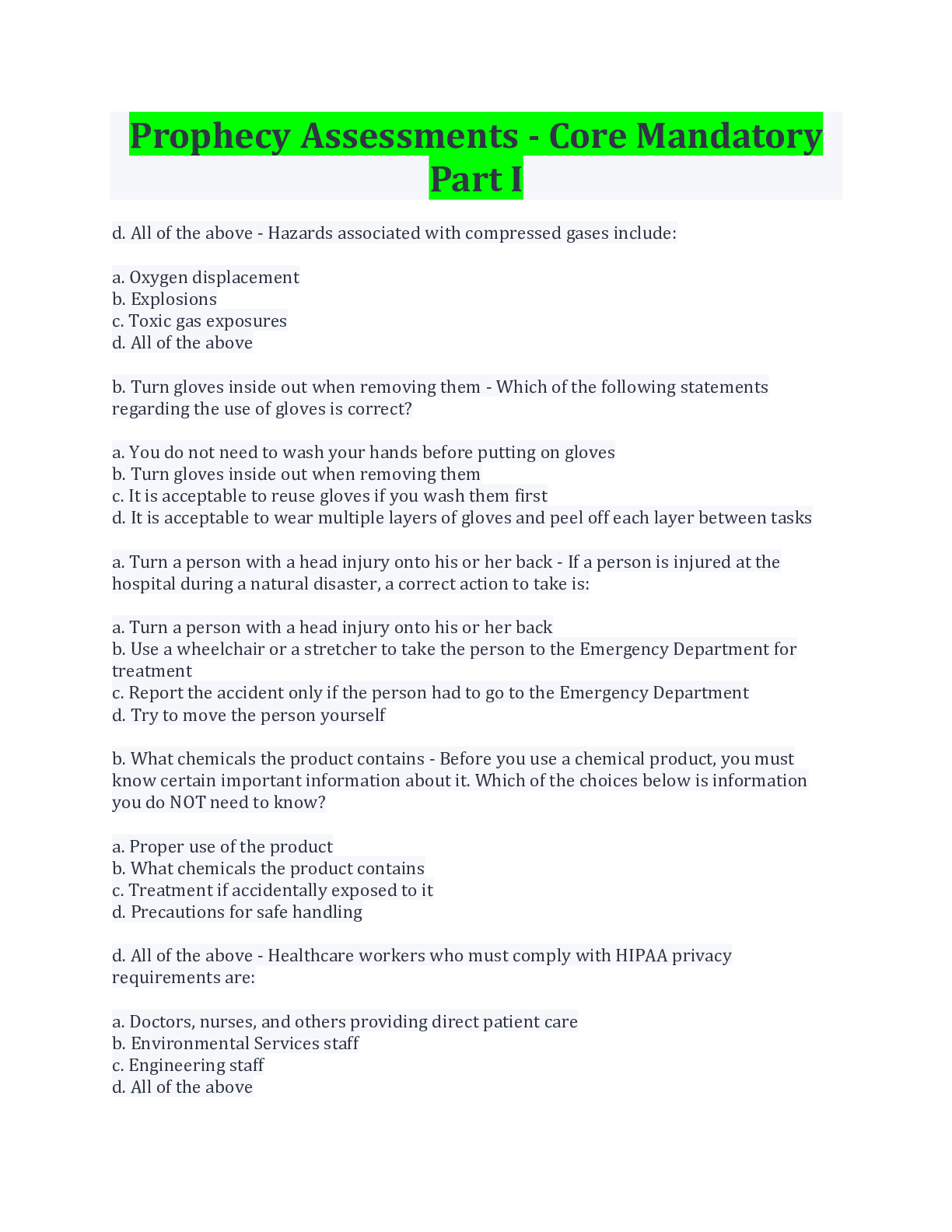
.png)
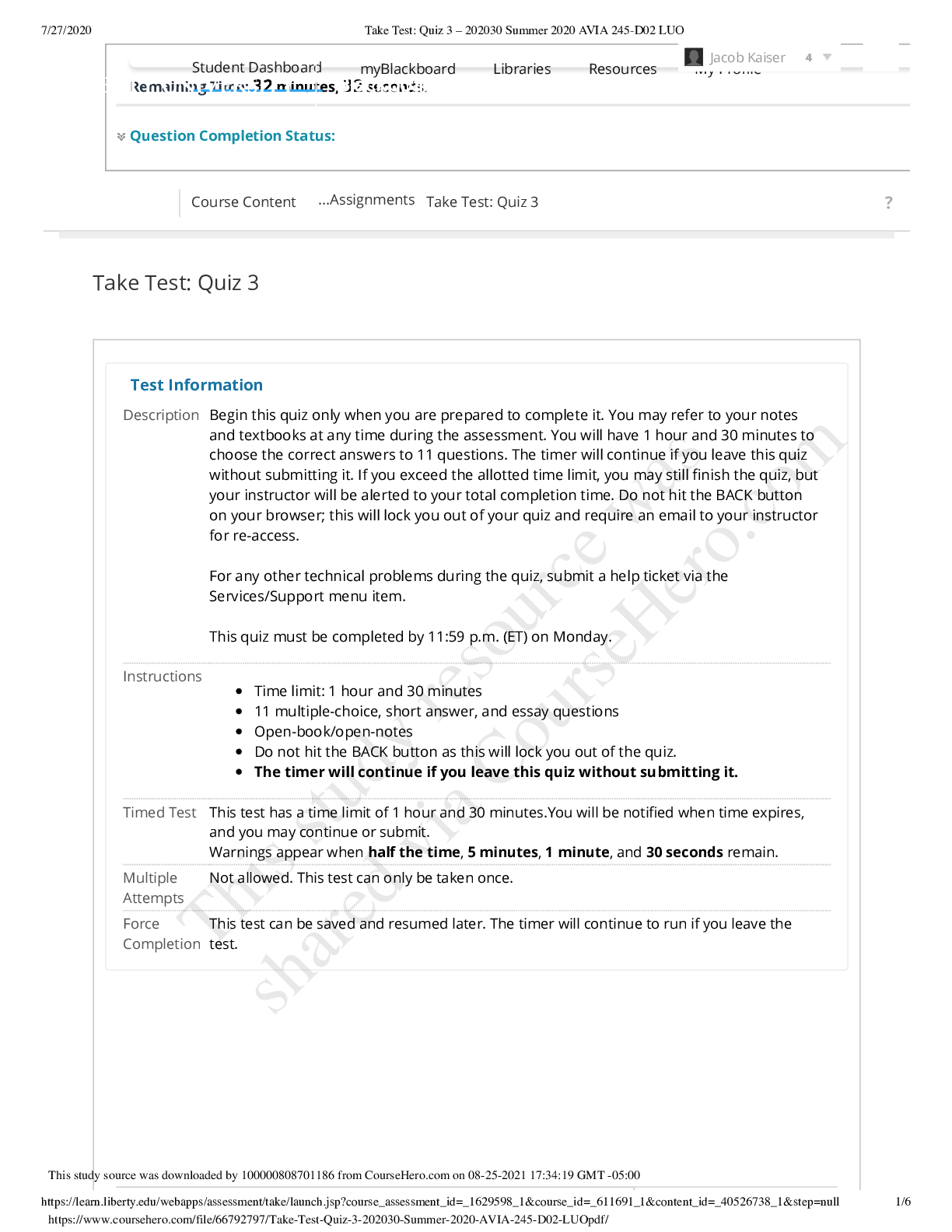
.png)
